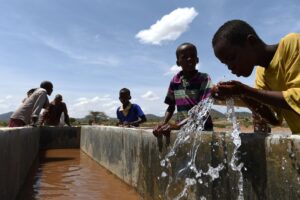At least 120 people have died after a devastating flash flood swept through homes and holiday camps in central Texas in the early hours of 4 July.
The disaster unfolded after a severe rainstorm caused the Guadalupe River to swell to its second-greatest height on record.
Headlines have been dominated by the death of 27 children and counsellors from a summer camp for girls near the banks of the river.
In the aftermath of the flooding, many news outlets questioned whether the Trump administration’s decision to cut staff from the federal climate, weather and disaster response services may have impacted the emergency response to the disaster.
However, others defended the agency’s actions, saying that the appropriate warnings had been issued.
Scientists have been quick to point out the role of climate change in driving more intense rainfall events.
A rapid attribution analysis found “natural variability alone” could not explain the extreme rainfall observed during the “very exceptional meteorological event”.
Meanwhile, social media has also been awash with misinformation, including claims that the floods were caused by geoengineering – an argument that was quickly dismissed by officials.
In this article, Carbon Brief unpacks how the flood unfolded, the potential role of climate change and whether advanced warnings were affected by funding cuts to key agencies.
- How did the flooding develop?
- What impact did the flooding have?
- What role did climate change play?
- Were the forecasts and warnings affected by recent job cuts?
- What conspiracy theories have been circulating?
- How has the media responded?
How did the flooding develop?
The flash flooding began in the early hours of the morning on Friday 4 July, with early news coverage focusing on Guadalupe River in Kerr County.
According to BBC News, the US National Weather Service (NWS) reported a “swathe of around 5-10 inches (125-250mm) of rainfall in just three to six hours across south-central Kerr County”, equivalent to “around four months of rain [falling] in a matter of hours”.
The slow-moving weather system was fed by moisture from the remnants of Tropical Storm Barry, which had brought flooding to Mexico, before tracking north as it died out, the outlet explained.
Kerr County is a “hillier part of Texas than surrounding counties”, meaning that “moisture-laden air was forced upwards, building huge storm clouds”, the article noted:
“These storm clouds were so large they effectively became their own weather system, producing huge amounts of rain over a large area.”
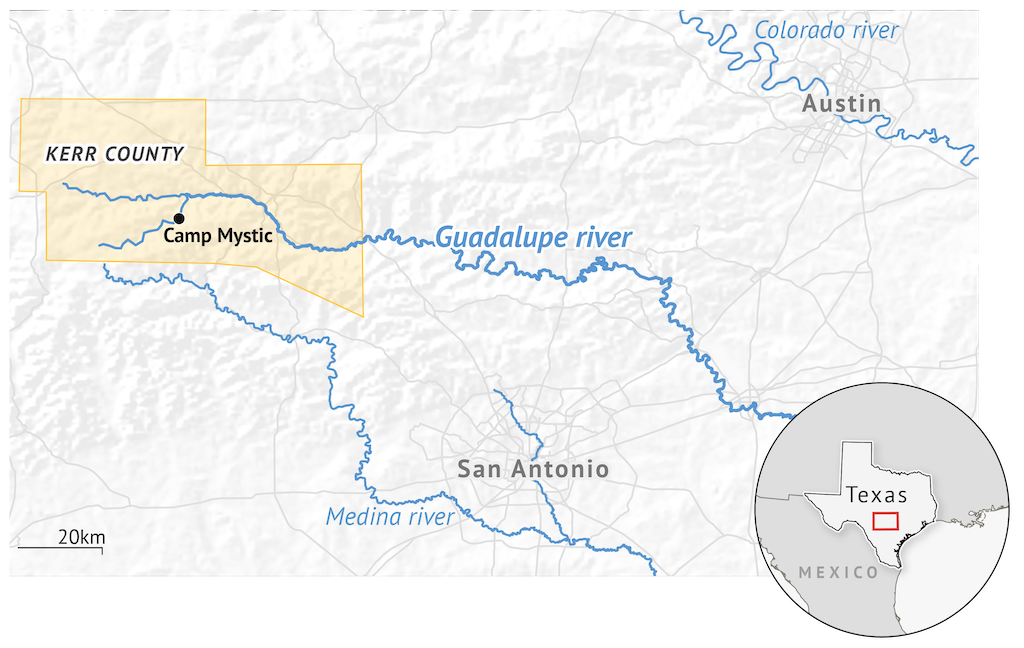
Prof Hatin Sharif, a hydrologist and civil engineer at the University of Texas at San Antonio, explained in an article for the Conversation why Kerr County is part of an area known as “flash flood alley”:
“The hills are steep and the water moves quickly when it floods. This is a semi-arid area with soils that don’t soak up much water, so the water sheets off quickly and the shallow creeks can rise fast.”
He added that Texas as a whole “leads the nation in flood deaths” – by a “wide margin”.
As the rain lashed down, the “destructive, fast-moving waters” of Guadalupe River rose by 8 metres in just 45 minutes before daybreak on Friday, said the Associated Press, “washing away homes and vehicles”.
The Washington Post reported that the river reached its “second-greatest height on record…and higher than levels reached when floodwaters rose in 1987”. It added that “at least 1.8tn gallons of rain” fell over the region on Friday morning.
The floodwaters swept through camps, resorts and motorhome parks along the banks of Guadalupe River for the Fourth of July weekend.
A timeline of events by NPR reported that “boats and other equipment that was pre-positioned started responding immediately”.
The article quotes Texas lieutenant governor Dan Patrick, who said there were 14 helicopters, 12 drones and nine rescue teams in action – as well as “swimmers in the water rescuing adults and children out of trees”. He added that there were 400 to 500 people on the ground helping with the rescue effort.
By Saturday 5 July, more than 1,000 local, state and federal personnel were on the ground helping with the rescue operation, NPR said.
In the days that followed, further periods of heavy rainfall meant that flood watches remained in place for much of the weekend, said Bloomberg.
Newspapers and online outlets were filled with images from the area. For example, the Sunday Times carried photos and video footage of the floods, while BBC News had drone footage of the “catastrophic flooding”.
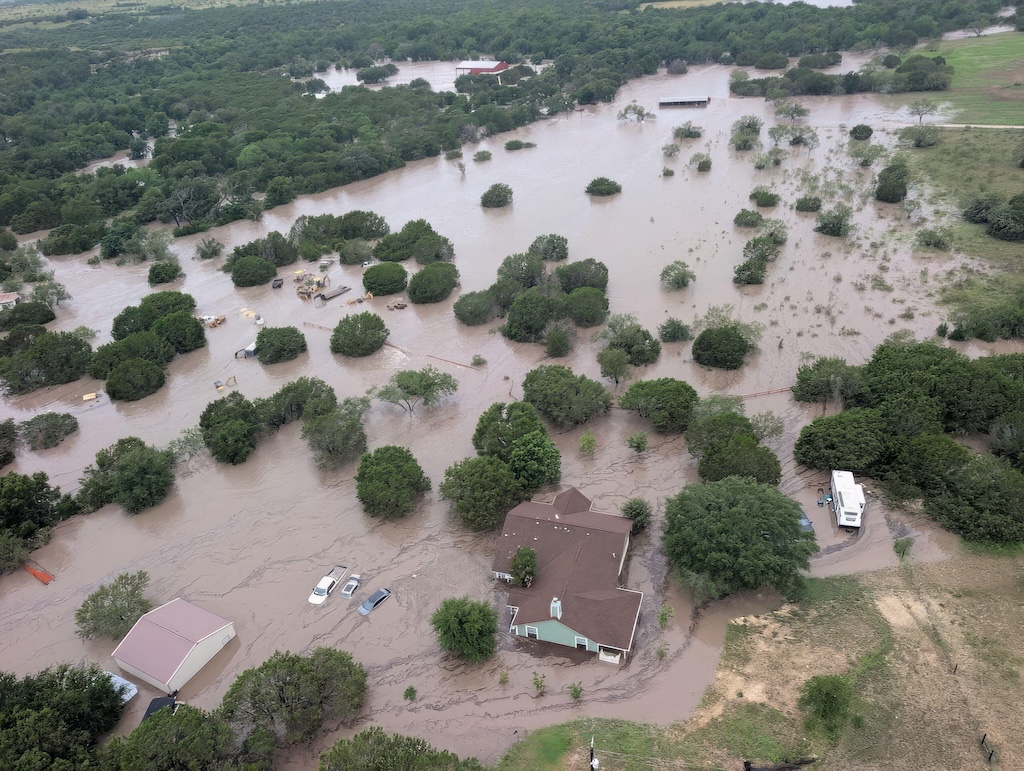
What impact did the flooding have?
The floods have killed at least 119 people, according to the latest count reports by the Guardian:
“In Kerr county, the area that was worst affected by last Friday’s flood, officials said on Wednesday morning that 95 people had died. The other 24 people who have died are from surrounding areas. The Kerr county sheriff said 59 adults and 36 children had died, with 27 bodies still unidentified.”
There are also 173 people believed to still be missing, the Guardian said, including 161 from Kerr County specifically.
Bloomberg noted that “some of the victims came from additional storms around the state capital Austin on 5 July”. It added that, according to officials, “no one had been found alive since 4 July, when the deluge arrived in the pre-dawn hours”.
BBC News reported that continuing rains following the initial flood “hamper[ed] rescue teams who are already facing venomous snakes as they sift through mud and debris”.
Headlines have been dominated by the death of 27 children and counsellors from Camp Mystic – a 700-acre summer camp for girls, which has been running for almost 100 years, noted the Guardian.
BBC News reported that “many of the hundreds of girls at the camp were sleeping in low-lying cabins less than 500ft (150 metres) from the riverbank”.
Lieutenant governor Patrick “told of one heroic camp counsellor who smashed a window so girls in their pyjamas could swim out through neck-high water”, the outlet reported. He added that “these little girls, they swam for about 10 or 15 minutes” before reaching safety.
The Associated Press reported:
“Dozens of families shared in local Facebook groups that they received devastating phone calls from safety officials informing them that their daughters had not yet been located among the washed-away camp cabins and downed trees. Camp Mystic said in an email to parents of the roughly 750 campers that if they have not been contacted directly, their child is accounted for.”
The New York Times published images and videos of the aftermath at the summer camp.
Visiting the site on Sunday 6 July, Texas governor Greg Abbott tweeted that the camp was “horrendously ravaged in ways unlike I’ve seen in any natural disaster”.
In the immediate aftermath of the floods, US president Donald Trump, at his golf club in Bedminster in New Jersey, signed a major disaster declaration that freed up resources for the state, reported France24.
A preliminary estimate by the private weather service AccuWeather put the damage and economic loss at $18bn-$22bn (£13.2bn-£16.2bn), the Guardian reported.
Former president Barack Obama described the events as “absolutely heartbreaking”, reported the Hill. In a statement, former president George W Bush and his wife Laura – who was once a counselor at the camp – said that they “are heartbroken by the loss of life and the agony so many are feeling”, another Hill article reported.
American-born pontiff Pope Leo XIV also “voiced his sympathies”, reported another Guardian article. Speaking at the Vatican, he said:
“I would like to express sincere condolences to all the families who have lost loved ones, in particular their daughters who were in a summer camp in the disaster caused by flooding of the Guadalupe River in Texas.”

What role did climate change play?
As the planet warms, extreme rainfall events are becoming more intense in many parts of the world.
This is principally because, according to the Clausius-Clapeyron (C-C) equation, the air is able to hold 7% more moisture for every 1C that the atmosphere warms, which means warmer air can release more liquid water when it rains.
For example, a recent study of the US found that the frequency of heavy rainfall at “durations from hourly to daily increased in 1949-2020”. It added that this was “likely inconsistent with natural climate variability”.
In addition, research indicates that, in some parts of the world, increases in the intensity of extreme rainfall over 1-3 hours are “stronger” than would be expected from the C-C scaling.
However, many other factors – such as local weather patterns and land use – affect whether extreme rainfall leads to flooding.
Local meteorologist Cary Burgess told Newsweek that “this part of the Texas Hill Country is very prone to flash flooding because of the rugged terrain and rocky landscape”. For example, the outlet notes, 10 teenagers died in flash floods in July 1987.
In the aftermath of the flooding in Texas, Dr Daniel Swain, a climate scientist at the University of California Agriculture and Natural Resources, told ABC News that there is “abundant evidence” that “highly extreme rain events” have “already increased considerably around the world as a result of the warming that’s already occurred”.
Prof Andrew Dessler from Texas A&M University wrote on climate science newsletter The Climate Brink that “more water in the air flowing into the storm will lead to more intense rainfall”. He added:
“The role of climate change is like steroids for the weather – it injects an extra dose of intensity into existing weather patterns.”
Dr Jennifer Francis, a climate scientist at the Woodwell Climate Research Center, told Bloomberg that Texas is “particularly flood-prone because the fever-hot Gulf of Mexico is right next door, providing plenty of tropical moisture to fuel storms when they come along”.
Many outlets pointed out the higher-than-average sea surface temperatures in the Gulf of Mexico. BBC News said:
“Sea surface temperatures in the Gulf of Mexico, where some of the air originated from, continue to be warmer than normal. Warmer waters mean more evaporation and so more available moisture in the atmosphere to feed a storm.”
Yale Climate Connections reported that sea surface temperatures were up to 1C above average in the central Gulf of Mexico. It said that human-caused climate change made these conditions up to 10 times more likely, according to the Climate Shift Index from Climate Central.
(This index gives the ratio of how common the temperature is in today’s climate, compared to how likely it would be in a world without climate change.)
Bloomberg was among a number of outlets to note that, in the run-up to the flooding, nearly 90% of Kerr County was experiencing “extreme” or “exceptional” drought. This meant the soil was hard and less able to soak in water when the intense rainfall arrived.
Just days after the event, rapid attribution group ClimaMeter published an analysis of the meteorological conditions that led to the flooding.
It stated that “conditions similar to those of the July 2025 Texas floods are becoming more favorable for extreme precipitation, in line with what would be expected under continued global warming”.
According to the analysis, the flooding was a “very exceptional meteorological event”. It explained that “meteorological conditions” similar to those that caused the floods are “up to 2 mm/day (up to 7%) wetter in the present than they have been in the past”. It added:
“Natural variability alone cannot explain the changes in precipitation associated with this very exceptional meteorological condition.”
The field of extreme weather attribution aims to find the “fingerprint” of climate change in extreme events such as floods, droughts and heatwaves.
ClimaMeter focuses on the atmospheric circulation patterns that cause an extreme event – for example, a low-pressure system in a particular region. Once an event is defined, the scientists search the historical record to find events with similar circulation patterns to calculate how the intensity of the events has changed over time.
The study authors warned that they have “low confidence in the robustness” of their conclusions for this study, because the event is “very exceptional in the data record”, so they do not have many past events to compare it to.
In its coverage of the attribution study, the Wall Street Journal highlighted some of the research’s limitations. It said:
“Remnant moisture from Tropical Storm Barry stalled over the region and repeatedly fed rainfall, making it hard to compare the weather pattern to historical data.”
The outlet quoted one of the study’s co-authors, Dr Davide Faranda, a scientist at France’s National Centre for Scientific Research, who said the data “nonetheless suggests that climate change played a role”.
Many other climate scientists have also linked the flooding to climate change.
For example, Dr Leslie Mabon, a senior lecturer in environmental systems at the Open University, told the Science Media Centre:
“The Texas floods point to two issues. One is that there’s no such thing as a natural disaster – and one area that disaster experts will be probing is what warnings were given and when. The second is that the pace and scale of climate change means extreme events can and do exceed what our infrastructure and built environment is able to cope with.”
Were the forecasts and warnings affected by recent job cuts?
Observers were quick to question how the response to the floods has been impacted by recent sweeping cuts to federal climate, weather and disaster response services by the Trump administration.
BBC News explained how staffing cuts overseen by the so-called Department of Government Efficiency – the initiative formerly led by Elon Musk – have reduced the workforce National Weather Service (NWS).
The news outlet reported that – since the start of the year – “most” probationary employees had their contracts terminated, 200 employees have taken voluntary redundancy, 300 opted for early retirement and 100 were “ultimately fired”.
(The Trump administration has also proposed a 25% cut to the budget of the National Oceanic and Atmospheric Administration (NOAA) – the agency which oversees the NWS – but this would not come into force until the 2026 financial year.)
The Independent was among a raft of publications to report the weather service had predicted 1-3 inches (2.5-7.6cm) of rain for the region – significantly less than the 10-15 inches (25-38cm) that ultimately fell.
CNN detailed how the first “life-threatening flash flooding warning” for parts of Kerr County – which would have triggered alerts to mobile phones in the area – was issued just past 1am on Friday morning by the NWS. This was 12 hours after the first flash flood warning and followed “several technical forecasts” issued on Thursday afternoon and evening with “increasingly heightened language”, it said.
Other publications focused on staffing shortages at local branches of the weather service. The New York Times and Guardian were among the outlets who reported that “key staff members” had been missing at the two Texas NWS offices involved in forecasting and warning for the affected region. This included a “warning coordination” officer.
Writing on social media platform BlueSky, Dr Daniel Swain – the climate scientist from the University of California Agriculture and Natural Resources – said claims that the weather service “did not foresee” the floods were “simply not true”. He stated:
“This truly was a sudden and massive event and occurred at [the] worst possible time (middle of the night). But [the] problem, once again, was not a bad weather prediction: it was one of “last mile” forecast/warning dissemination.
“I am not aware of the details surrounding staffing levels at the local NWS offices involved, nor how that might have played into [the] timing/sequence of warnings involved. But I do know that locations that flooded catastrophically had at least 1-2+ hours of direct warning from NWS.”
Rick Spinrad, who led NOAA over 2021-25, speculated that the communication problems could have been caused by staffing shortages. He told the Hill:
“I do think the cuts are contributing to the inability of emergency managers to respond…The weather service did a really good job, actually, in getting watches and warnings and…wireless emergency alerts out.
“It is really a little early to give a specific analysis of where things might have broken down, but from what I’ve seen, it seems like the communications breakdown in the last mile is where most of the problem was.”
The Trump administration, meanwhile, was quick to push back on the suggestion that budget and job cuts to climate and weather services had aggravated the situation.
In an official statement provided to Axios, a White House spokesperson said criticisms of the NWS and funding cut accusations were “shameful and disgusting”. It added:
“False claims about the NWS have been repeatedly debunked by meteorologists, experts and other public reporting. The NWS did their job, even issuing a flood watch more than 12 hours in advance.”
Meanwhile, when a reporter asked Trump whether the administration would investigate whether recent cuts had led to “key” vacancies at the NWS, he responded that “they did not”.
Asked if he thought federal meteorologists should be rehired, Trump said:
“I would think not. This was the thing that happened in seconds. Nobody expected it. Nobody saw it.”
Media outlets highlighted how the disaster put a spotlight on the risks of forthcoming federal cuts to NOAA and the government’s plans to dismantle the Federal Emergency Management Agency (FEMA).
The Guardian reported on warnings that such floods could become the “new normal” as “Trump and his allies dismantle crucial federal agencies that help states prepare and respond to extreme weather and other hazards”.
Dr Samantha Montano, professor of emergency management at Massachusetts Maritime Academy, told the outlet.
“This is what happens when you let climate change run unabated and break apart the emergency management system – without investing in that system at the local and state level.”
CBS News reported about how, in 2017, Kerr County officials rejected proposals to install an outdoor warning system for floods on the grounds of cost. The outlet noted that neighbouring counties Guadalupe and Comal both have flood sirens in place.
What conspiracy theories have been circulating?
As with many other natural disasters, the floods have been followed by a wave of fast-spreading online misinformation.
One of the most popular theories to have taken hold is that the floods were caused by cloud seeding – a form of geoengineering where substances are purposefully introduced into the clouds to enhance rainfall.
In a pair of Twitter posts, each viewed by several million people, one account claimed the state of Texas was “running seven massive cloud seeding programs” and asked: “Did they push the clouds too far and trigger this flood?”
It also linked the floods and cloud seeding operations conducted by Rainmaker Technology Corporation, a weather modification start-up partly funded by US billionaire Peter Thiel.
Rainmaker Technology Corporation CEO Augustus Doricko found himself in the eye of the social media storm, as social media users pointed to his organisation’s links to Thiel and shared a photo of the businessman with former US president Bill Clinton.
The cloud seeding theory received a major boost when it was promoted by Mike Flynn, Donald Trump’s former national security advisor and one of the “most integral figures in the QAnon movement”, according to the Guardian.
The weather modification theory was picked up by existing and prospective Republican politicians.
The Daily Beast reported how Kandiss Taylor – a Republican congressional candidate in Georgia – blamed the event on “fake weather” in a string of tweets. She wrote: “This isn’t just ‘climate change.’ It’s cloud seeding, geoengineering, & manipulation.”
Meanwhile, sitting Georgia congresswoman Marjorie Taylor Greene announced on Twitter that she had introduced a bill that “prohibits the injection, release, or dispersion of chemicals or substances into the atmosphere for the express purpose of altering weather, temperature, climate, or sunlight intensity”.
(This is not Taylor Greene’s first foray into weather manipulation conspiracies. In 2021, she postulated that Jewish bankers had started deadly fires in California in 2018 by firing a laser from space in order to benefit themselves financially.)
Meteorologists were quick to debunk the claims around cloud seeding. In a Facebook post, chief meteorologist for Texas news station ABC13 wrote:
“Cloud seeding cannot create a storm of this magnitude or size. In fact, cloud seeding cannot even create a single cloud. All it can do is take an existing cloud and enhance the rainfall by up to 20%.”
At a press conference on Monday, Texas senator Ted Cruz said there was “zero evidence of anything like weather modification”. He added:
“The internet can be a strange place. People can come up with all sorts of crazy theories.”
Theories about geoengineering were not the only form of misinformation to swirl online in the wake of the disaster.
Snopes reported how local outlet Kerr County Lead pulled a story about two girls rescued 30 metres up a tree two days after the flood event after the account was found to be false.
The story, which cited “sources on the ground”, was circulated widely on Twitter and replicated by other news outlets, including the Daily Mirror and Manchester Evening News in the UK. Both outlets subsequently deleted the articles.
In a retraction statement, the editor of Kerr County Lead said the story was a “classic tale of misinformation that consumes all of us during a natural disaster”.
Another widely-circulated story – debunked by Snopes – claimed that musician Eric Clapton would pay funeral expenses for the families of those killed.
How has the media responded?
The scale of flooding and the resulting death toll have prompted many news outlets to ask whether more could have been done to avoid the tragedy.
Newspapers in Texas highlighted perceived failures by local, state and federal authorities.
“Flash floods happen frequently enough in the Hill Country that many Texans rightly wonder whether at least some of the devastation and death…could have been prevented,” the Dallas Morning News said. “Answers must follow,” agreed the Austin American-Statesman.
An editorial in the San Antonio Express-News said there would likely be “plenty of finger-pointing”, arguing that “people will try to push narratives that serve political and personal agendas”. It added:
“The truth may reveal inevitability, failure or something in between.”
An editorial in the Houston Chronicle criticised “misguided decisions” by Trump to cut support for the “federal agencies that keep us safe from storms”. It stated:
“What will protect Texans is a fully staffed, fully supported weather service – with the scientists and infrastructure in place to warn us in time.”
While none of these Texan newspaper editorials pointed to a potential role for climate change in exacerbating the extreme rainfall, some of their wider reporting on the disaster did.
Other US news outlets, such as the New York Times, the Los Angeles Times and the Washington Post emphasised this link in their coverage.
“We hope this tragedy will lead to renewed support for the systems we’ve devised over the years to help prepare for and respond to natural disasters,” Louisiana’s New Orleans Advocate stated in an editorial, adding that “we all are vulnerable to increasingly extreme weather events caused by climate change”.
In Pennsylvania, a Patriot-News editorial said that, following the floods, “government officials at all levels need to accept the reality of climate change. Too many do not.”
Writing in his news outlet, Bloomberg, businessman and former Democratic presidential nominee Michael Bloomberg made a direct link between the “climate denialism” of the Trump administration and the disaster in Texas.
The New York Times has an opinion piece on the floods by MaryAnn Tierney, former regional administrator at the FEMA. Besides making a clear link to climate change, Tierney stated that:
“The uncomfortable truth is this: With each passing day, the federal government is becoming less prepared to face the next big disaster.”
More overtly right-leaning and Trump-supporting media outlets in the US took aim at “left-wing critics” for linking the event to climate change and Trump administration cuts.
An article in Fox News, which has broadcast discussions of flood-related conspiracy theories, criticised “liberals” for “politicising the disastrous flooding”.
An editorial in the New York Post is headlined: “Lefty responses to the Texas flooding horror are demented and depraved.” It argued that Democrats had “wrongly suggest[ed] that Team Trump slowed the disaster response”.
Diana Furchtgott-Roth, from the climate-sceptic Heritage Foundation, wrote in the UK’s Daily Telegraph that Democrats were trying to “politicise mother nature” by linking weather-service cuts to the deaths in Texas.
Meanwhile, Guardian columnist Rebecca Solnit urged caution in definitively linking the floods to any specific political issue amid “the information onslaughts of this moment”. She concluded that “both the weather and the news require vigilance.”
The post Media reaction: The 2025 Texas floods and the role of climate change appeared first on Carbon Brief.
Media reaction: The 2025 Texas floods and the role of climate change
Greenhouse Gases
Revealed: ‘Cali Fund’ for nature still empty as emails show industry hesitation
A major fund for biodiversity remains starved of resources more than five months after its launch – with no money yet put forward by the large companies who could contribute.
The “landmark” Cali Fund – which could generate billions of pounds each year – was created under the UN Convention on Biological Diversity (CBD) at the COP16 nature negotiations in Cali, Colombia last autumn.
Countries agreed that certain companies “should” pay into the fund, but this is not legally binding and donations are, ultimately, voluntary.
The fund is designed to be a way for companies who rely on nature’s genetic resources to share some of their earnings with the developing, biodiverse countries where many of the original resources are found.
Companies use genetic data from these materials to develop products, such as vaccines and skin cream.
Emails released to Carbon Brief under the UK Freedom of Information (FOI) Act show that companies were contacted with opportunities to be involved in the Cali Fund before its launch in February 2025.
Pharmaceutical giant AstraZeneca did not take up an offer from a UK government department to be a “frontrunner” in committing to donate to the fund, the emails show.
GSK, another major company in the sector, also did not confirm its position.
These are the UK’s two largest pharmaceutical companies and they could each potentially contribute tens of millions of pounds to the fund, based on current guidelines.
Earlier this year, a spokesperson for the CBD said that the first contributions to the Cali Fund could be announced in spring.
One US biotechnology company has pledged to contribute to the fund in the future, but, for now, the fund remains empty.
Company hesitancy could be “driven by industry bodies” who “don’t want unhappy precedents to be set” on the level of funding, a researcher who was involved in the fund negotiations tells Carbon Brief.
Lack of funds
Companies all around the world use genetic materials from plants, animals, bacteria and fungi to develop their products.
There are existing rules in place to secure consent and compensation, if companies or researchers physically travel to a country to gather these materials.
But, currently, much of this information is available in online databases – with few rules in place around the requirements needed for access. This genetic data is known as digital sequence information (DSI).
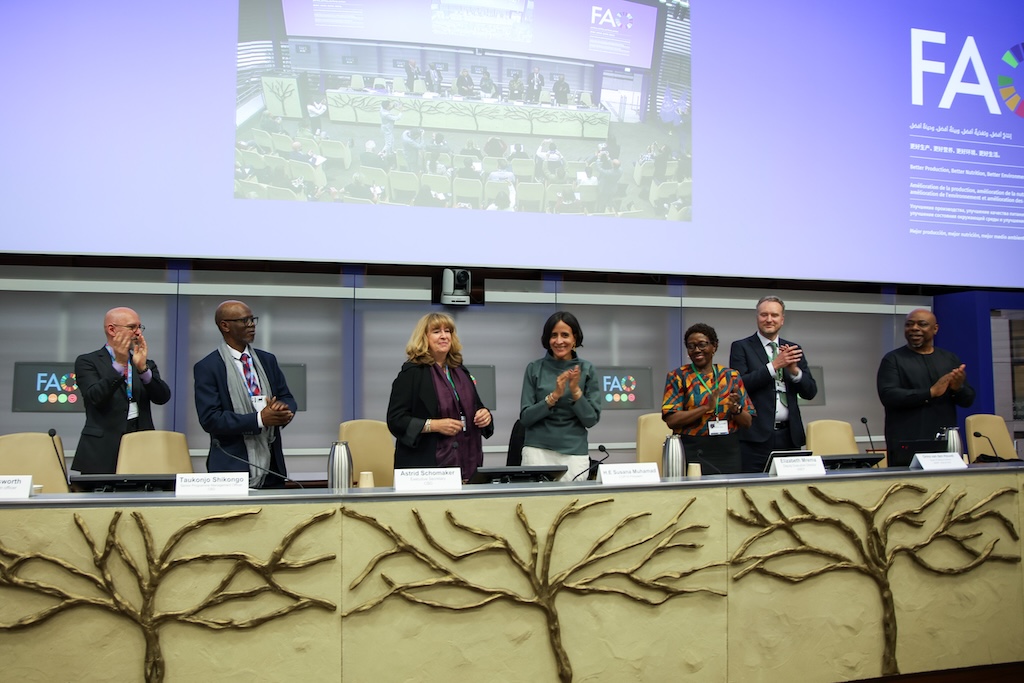
In an effort to close the loophole, almost every country in the world agreed in 2024 to set up the Cali Fund.
The agreement outlines that large companies in sectors including pharmaceutical, cosmetic, biotechnology, agribusiness and technology “should” contribute to the fund to share back a cut of the money they earn from the use of these materials. (See: Carbon Brief’s infographic on DSI.)
However, these contributions are voluntary. Many African and Latin American countries sought a legally binding mechanism around this issue at COP16, but this did not happen.
The fund officially opened at the resumed COP16 negotiations in Rome in February 2025.
With the fund still empty more than five months later, a spokesperson for the CBD secretariat tells Carbon Brief that a US-based biotechnology firm, Ginkgo Bioworks, is the first to “indicat[e] its intention to contribute”.
The CBD, also acting as the interim secretariat for the new fund, “continue[s] to engage with business associations to raise awareness and secure funding”, the spokesperson says.
They add that a decision-making body and a steering committee have been set up.

The CBD received “positive feedback and engagement” from companies about the fund, the UN biodiversity chief Astrid Schomaker said in a February press conference. She added that donations were expected “very soon”, but not in “massive numbers”.
Carbon Brief contacted Ginkgo Bioworks for comment, but did not receive a response in time for publication.
‘Frontrunner’ contributors
Through an FOI request, Carbon Brief received email correspondence between the UK Department for Environment, Food & Rural Affairs (Defra), major pharmaceutical companies AstraZeneca and GSK, and trade group the Association of the British Pharmaceutical Industry (ABPI) between August 2024 and April 2025. (Carbon Brief has uploaded the FOI documents it received to a Google Drive folder.)
A representative from Defra told AstraZeneca in December 2024 that they were contacting a “select number of companies that will likely be frontrunners with the Cali Fund and make contributions – leading the way for others to follow suit”.
The Defra employee said that they had received “some positive signals from these companies” and asked if AstraZeneca was interested in “demonstrating commitment in this start-up phase of the fund”. This email said:
“I hope this finds you well – and thanks for joining various calls over the last few weeks on DSI, it’s great to have you involved. I know that AZ have been really forward leaning on ABS issues in the past (including under your leadership) and now that we have the Cali Fund for benefit sharing from the use of DSI, I wondered if we might pick up the conversation on any role AZ might be able to take as an early mover in the ABS world?
“We are beginning to have conversations with a select number of companies that will likely be frontrunners with the Cali Fund, and make contributions – leading the way for others to follow suit – and we have had some positive signals. Do you think there might be any interest from AZ in demonstrating commitment in this start-up phase of the Fund? If it would be helpful to have a conversation to chat through, please do let me know and I’d be super happy to set something up.”
The AstraZeneca representative responded to say the company was “in the process of conducting an assessment to define our position” on the fund and that they would “welcome a conversation” when this concluded.
A Defra official contacted the company again in early January to say the government was preparing meetings between a member of the CBD secretariat and several businesses “that have shown some interest in leading others by making the first contributions to the fund”.
They asked if AstraZeneca was interested in attending this meeting. The company declined, but said it would be interested in future discussions.
An AstraZeneca spokesperson declined to respond to Carbon Brief’s questions, but Carbon Brief understands that the company is still reviewing its position on the fund.

Similar exchanges took place between representatives from Defra and GSK ahead of the Cali Fund launch.
GSK was invited to the same January meetings, but the company said nobody was available to attend. A Defra official contacted GSK in February to update on progress with the fund, outlining that it would be launched in Rome, “accompanied by a platform for announcements and press coverage”.
The Defra official asked GSK to let them know “if you think there might be any opportunities for GSK – we would obviously love to add your voice to the positive coverage”. The email read:
“As a broader update, we are still expecting the Fund to formally launch in Rome at COP16.2, and that will be accompanied by a platform for announcements and press coverage. We are also working with another CBD Party to explore the option of putting on some kind of reception for those businesses that are leading the way together.
“Please do let me know if you think there might be any opportunities for GSK – we would obviously love to add your voice to the positive coverage!”
They also asked if GSK would like to see a draft version of a press release from the CBD about the launch of the Cali Fund, along with other businesses “that are interested in being part of the launch”.
(The Cali Fund launch press release did not contain any quotes or donation announcements from companies.)
GSK said that it was “awaiting further clarification on a number of key elements” before making a decision on the Cali Fund and would respond “in due course”.
The company “support[s] the intent” behind the fund, a spokesperson tells Carbon Brief, adding:
“We’ll make a decision regarding voluntary contributions when more information becomes available about how the Cali Fund sits alongside other multilateral mechanisms.
“GSK was one of the first companies to publish a nature strategy and we continue to work on delivering our plan to address our nature impacts and invest in nature protection and restoration.”
A Defra spokesperson tells Carbon Brief:
“Nature underpins everything and those who profit from the use of genetic data should pay nature back. The Cali Fund provides the route for companies to do that.
“The government is committed to continuing to engage constructively with industry to drive contributions and champion the fund to protect nature and sustain innovation.”
The UK and Chile recently launched the “friends of the Cali Fund” group, which “brings together” governments and businesses to “champion” benefits sharing, a UK government statement said. Norway, Germany, the Netherlands and Colombia have also joined this group.
UK companies could contribute £64m
Contributions to the Cali Fund are voluntary. They will depend on whether companies that rely on the use of genetic data will then admit to using genetic materials and decide to pay into the fund.
The agreement behind the fund, which is not legally binding, outlined that companies “should” contribute 1% of their profits, or 0.1% of their revenue. These are an “indicative rate”.
Words that are more binding, such as “will” and “shall”, were included in non-paper negotiation texts during the talks. But the final agreement referred to a fund that companies “should” pay into, which was criticised by some experts at the time.
At least half of the money raised will go towards meeting the “self-identified” needs of Indigenous communities in developing countries, particularly women and young people.
The overall fund could generate between $1bn and $10bn each year, according to a 2024 analysis requested by the CBD.

The cache of information released under FOI to Carbon Brief also includes a report on the impacts of a mandatory payment for using digital sequence information, which was prepared for Defra by consultancy company ICF in July 2024.
It estimated that a mandatory 1% levy on the profits of large UK companies “who are considered DSI-dependent” could generate nearly £64m ($85m) for the fund.
The report compared three different benefit-sharing mechanisms around genetic data: a mandatory levy on UK profits/revenues; a flat fee; or a subscription fee.
All options would negatively impact on “innovation” to varying degrees, the report said, but a mandatory levy on profits was found to have the “least negative impact on competition and innovation”.
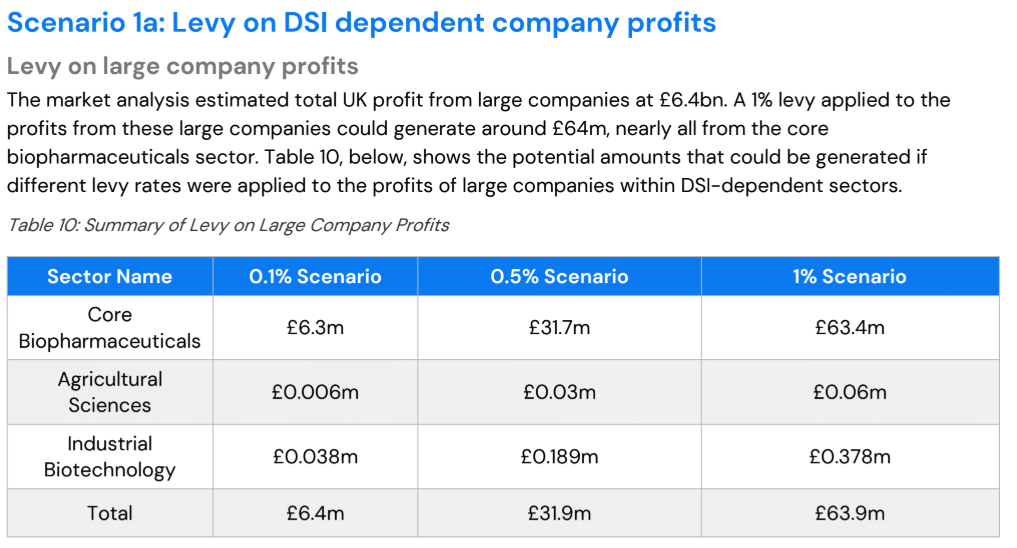
During the Cali Fund negotiations last October, the Guardian reported that AstraZeneca “said it may cut jobs” in the UK, if such a levy was introduced. An AstraZeneca spokesperson denied the comments, the newspaper said.
Based on the “indicative” contribution rates of 1% of profits or 0.1% of revenue, Carbon Brief estimates that AstraZeneca could potentially contribute as much as £41-66m ($54-88m) and GSK £31-35m ($41-46m) each year to the fund.
AstraZeneca reported revenue of £41bn ($54bn) and £6.6bn ($8.7bn) in profit before tax in 2024. GSK’s revenue that year was around £31bn ($40bn) and its pre-tax profit was £3.5bn ($4.6bn).
Lobbying concerns
At COP16, many observers were concerned about industry lobbying around digital sequence information.
DeSmog analysis of COP16 attendees highlighted the presence of big pharmaceutical companies, powerful industry groups and agribusiness at the talks.
The International Federation of Pharmaceutical Manufacturers and Associations (IFPMA), a global pharmaceutical trade group, said it had “serious concerns” about proposals around the fund at the start of COP16. The group said it would result in “regulatory and financial barriers that would stifle innovation, delay R&D [research and development] and complicate compliance”.
The emails obtained by Carbon Brief show that, in August 2024, a GSK representative told Defra that the company believed proposals for a “simplistic payment mechanism based on revenues would be disproportionate and could hinder the development of new medicines and vaccines”. This email said:
“You were asking for views on the call, so I also wanted to take the opportunity to share GSK’s perspective at this time. We are supportive of a practical and fair multilateral mechanism for benefit-sharing from the use of digital sequence information on genetic resources. The criteria for this mechanism listed in decision 15/9 are particularly important, specifically the fact that it must not hinder research and innovation.
“We are concerned that the current proposals for a simplistic payment mechanism based on revenues would be disproportionate and could hinder the development of new medicines and vaccines. We would support the consideration of other models, for example a subscription model whereby organisations that access open source DSI databases make a contribution to the global fund.
“This would have the benefit of broadening the base of contributors. Tiers could be established based on size of organisation, so that the contributions were proportionate and fair.”
The FOI release also shows that ABPI chief executive, Dr Richard Torbett, wrote a letter to UK nature minister Mary Creagh on 17 October 2024, a few days before the COP16 summit began.
He “urge[d]” the government to not agree on the details of a fund “until more work has been conducted to understand the implications of proposals”.
Torbett said that, if this was not possible, the ABPI wanted the government to support an option put forward by Japan and South Korea to introduce a voluntary funding mechanism.
Hesitancy potentially ‘driven by industry bodies’
In a statement after COP16, the IFPMA’s director general, Dr David Reddy, said the decision creating the Cali Fund “does not get the balance right between the intended benefits of such a mechanism and the significant costs to society and science that it has the potential to create”.
The FOI release obtained by Carbon Brief includes a 20 March 2025 document from the ABPI discussing possible future changes to the fund.
The group said the fund “contains and omits several features which make it unlikely to attract significant contributors”. The ABPI “cannot over-emphasise the importance” of the fund being voluntary, the document said, with companies “free to decide” if and how much they want to contribute.
The ABPI urged the UK to discourage any country-level implementation of the COP16 digital sequence information agreement, arguing that “conflicting” action on a national, rather than global, level would “reduce the (already weak) incentives to contribute to the Cali Fund”.
The ABPI also criticised the agreed 0.1% and 1% contribution rates for companies, saying they are “regarded by industries generally as being unrealistic and likely to impact innovation”.
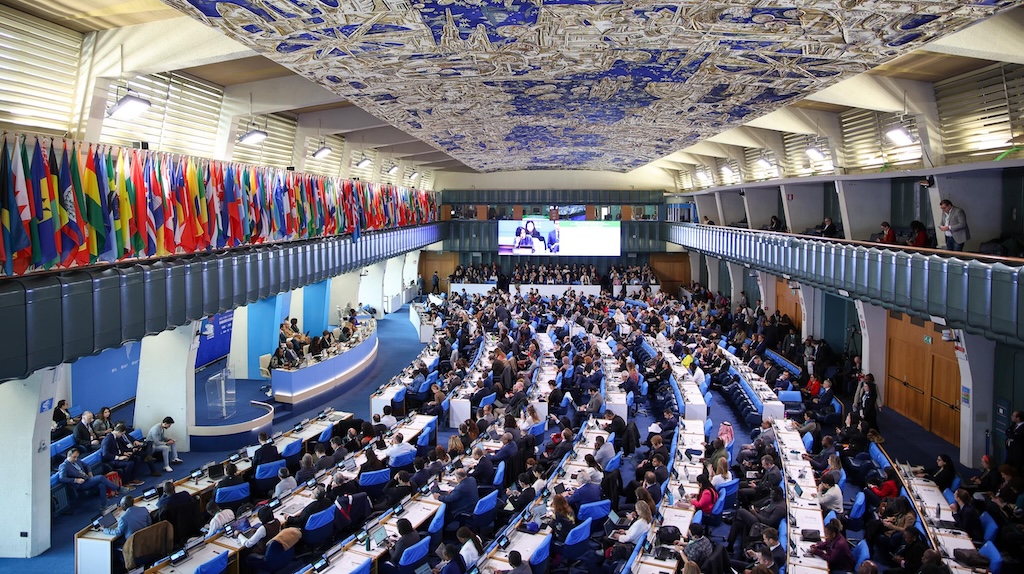
The ABPI declined to respond to Carbon Brief’s questions and referred Carbon Brief to the global trade group, the IFPMA. A spokesperson for the IFPMA also declined to respond to questions and pointed towards the company’s public statements on the issue.
Dr Siva Thambisetty, an associate professor of law at the London School of Economics and Political Science and project lead on an ocean biodiversity research group, believes the first contribution to the fund is a “prize that’s just waiting to be won”. She tells Carbon Brief:
“It would be an absolute coup for a responsible DSI company to be the first to make a contribution to the Cali Fund. Investors should be very interested in that company, for instance.
“We’ve got to move to a biodiversity market where investors are asking whether companies they invest in are contributing to remedy and repair at a global level through appropriate monetary benefit sharing.”
Thambisetty believes that this is “low-hanging fruit”, but acknowledges that companies have varying opinions on the fund and that the “majority might be unsure how to deal with this”. She adds:
“I think the hesitancy is mostly being driven by industry bodies because they don’t want unhappy precedents to be set. There is a collective action problem and the first company to break cover will be sending a signal that will be received differently by different people.”
The post Revealed: ‘Cali Fund’ for nature still empty as emails show industry hesitation appeared first on Carbon Brief.
Revealed: ‘Cali Fund’ for nature still empty as emails show industry hesitation
Greenhouse Gases
After Lobby Day, Congress is listening
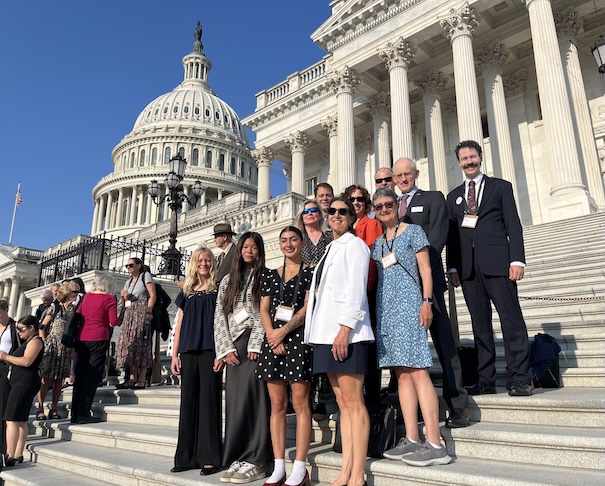
Members of CCL Utah were among those who met with the office of Sen. John Curtis on July 22, 2025.
After Lobby Day, Congress is listening
By Flannery Winchester
Just a few weeks ago, CCL volunteers held 402 lobby meetings with lawmakers on Capitol Hill. We know we made a big impression on Congress, with at least 10 lawmakers posting about our visits on social media in the days following our visit.
And this week, we’re seeing that they didn’t just notice us — they listened to us.
One of our Lobby Day asks was for lawmakers to reject guidance from the White House that might try to further restrict tax credits for clean energy like wind and solar.
About a week later, Politico reported that a “handful of Senate Republicans are escalating their pressure on the Trump administration to back off its efforts to strangle new solar and wind energy projects.”
The story names Sen. Mike Rounds of South Dakota, Sen. Thom Tillis of North Carolina, Sen. Lisa Murkowski of Alaska, and Sen. John Curtis of Utah — and CCL volunteers met with all of those offices, or the members themselves, on July 22.
This week, Sen. Chuck Grassley of Iowa joined Sen. Curtis in placing a hold on several Treasury Department nominees because of the agency’s expected clampdown on tax credits for wind and solar energy. CCLers met with Sen. Grassley on July 22, too.
It’s great to see this example of members of Congress following through on this key part of our primary ask!
This is why we show up in a respectful, nonpartisan way. This is why we work consistently to build more common ground in Congress. With every lobby meeting, our advocacy brings climate action and clean energy policy closer within reach.
The post After Lobby Day, Congress is listening appeared first on Citizens' Climate Lobby.
Greenhouse Gases
DeBriefed 1 August 2025: Trump targets ‘endangerment finding’; Floods and heatwaves; ‘Thirst’ exhibition
Welcome to Carbon Brief’s DeBriefed.
An essential guide to the week’s key developments relating to climate change.
This week
Trump to overturn ‘endangerment finding’
EPA OVERTURNING: The Trump administration announced its plan to overturn the 2009 finding that has been the “central basis” for US action to regulate greenhouse gas emissions, the Associated Press reported. A new Environmental Protection Agency proposal would rescind the “endangerment finding”, which determined that carbon dioxide and other greenhouse gases endanger public health and welfare, according to the newswire. If the finding is repealed, it would “erase current limits” on greenhouse gas pollution from cars, factories and power plants, AP said.
‘MISLEADING’ REPORT: The proposal is supported by a new Department of Energy report that uses “misleading and inaccurate” statements to argue that climate science has “overstated” the risks of a warming planet, Politico reported. The report, which also argues that climate science is “underestimating” the societal benefits of burning fossil fuels, was written by five scientists who “are known” for “denying accepted climate science”, the outlet added.
‘WINDMILL DISGRACE’: Wind development on federal lands and waters may be halted by the Trump administration, Bloomberg reported. Interior secretary Doug Burgum ordered a comprehensive review of the agency’s approval process, it said. According to Renewable Energy News, the department said more than 3.5m acres offshore were designated as “wind energy areas” by the last administration and that “terminating” these areas is “safeguarding” local environments and economies from “unchecked development”. This followed from Trump’s recent comment that “windmills are a disgrace”, the publication added.
Floods and heatwaves
SEVERE FLOODING: Torrential rains triggered a devastating flood in northern Nigeria, leaving at least 23 people dead, Deutsche Welle reported. The flooding has displaced 5,560 people and left dozens injured, according to the National Emergency Management Agency. More than 200 people have been killed in floods in Nigeria since the start of the rainy season in May this year, according to DW. The outlet reported that scientists have said climate change is fuelling many of these extreme weather occurrences.
BEIJING RAINS: China faced “another deadly rainy season” after 60 people were killed following days of torrential rain in Northern Beijing, reported Reuters. The outlet said climate change has made extreme weather “more frequent and intense”. Elsewhere, floodwaters from the Indus and Chenab rivers have “inundated” more than a dozen villages across Pakistan’s Punjab province, said India’s Tribune.
RECORD TEMPERATURE: Japan recorded its hottest day on record as temperatures reached 41.2C in southwest Tokyo, Al Jazeera reported. There were 16 heat-related deaths and more than 10,800 people were hospitalised with heatstroke last week, the outlet said. Meanwhile, the Iraqi government issued an official holiday in seven of its provinces as temperatures topped 50C, said Gulf News.
‘MILLIONS’ INSIDE: Temperatures soaring in the US have led to “millions” of Americans being warned to stay inside as some areas reach 48.8C, noted Newsweek. Heat warnings and advisories have been issued by the National Weather Service, according to the outlet.
Around the world
- ENERGY PLEDGE: The European Union has pledged to buy $750bn of energy from the US in exchange for a lower tariff rate under its trade deal with Trump. “Significant purchases” of US oil, liquified natural gas and nuclear fuel to replace Russian fossil fuels are included in the deal, CNBC reported. The Financial Times quoted energy experts saying the deal is a “pie in the sky” given that “US fossil fuel supplies [in 2024] to the bloc accounted for just $75bn”.
- COP30 COSTS: The UN held an “urgent meeting” over “sky-high” accommodation costs ahead of the COP30 climate summit in Brazil, Reuters reported. Meanwhile, the last US climate negotiators have been fired by the Trump administration, leaving the nation with “no official presence” at the summit, said CNN.
- ‘MELTING RAPIDLY’: Glaciers in Turkey’s southeast are melting rapidly due to rising global temperatures “amid human-caused climate change”, Al Jazeera reported.
- ‘SEWAGE CRISIS’: The US and Mexico have signed a deal to end the Tijuana “sewage crisis”, committing to update outdated wastewater infrastructure to handle higher flows triggered by worse flooding, said Inside Climate News.
- RENEWABLE ENERGY: Australia’s government has pledged to “substantially increase” its renewable energy underwriting scheme following concerns the nation will struggle to meet its 2030 power target, noted the Guardian. Meanwhile, New Zealand’s government has voted to resume gas and oil drilling despite an “outcry” from the opposition and environmental groups, reported the New Zealand Herald.
- ‘UNHELPFUL TUSSEL’: UN climate chief Simon Stiell paid a visit to Australia and urged the nation and Turkey to resolve their “long-running tussle” over who will host the COP31 summit, calling the delay “unhelpful and unnecessary”, Reuters reported.
66.8 million
The hectares of intact tropical forest that overlaps with oil blocks in the Democratic Republic of Congo, according to Earth Insight.
Latest climate research
- Climate change could make ‘droughts’ for wind power 15% longer | Carbon Brief
- A study of urban construction workers in Taiwan found that heat stress imposes “substantial economic burden” and results in productivity losses in the range of 29-41% | Nature Cities
- Drought will increasingly contribute to the collapse of many bird species that live in highly arid regions of the US | Biological Conservation
(For more, see Carbon Brief’s in-depth daily summaries of the top climate news stories on Monday, Tuesday, Wednesday, Thursday and Friday.)
Captured
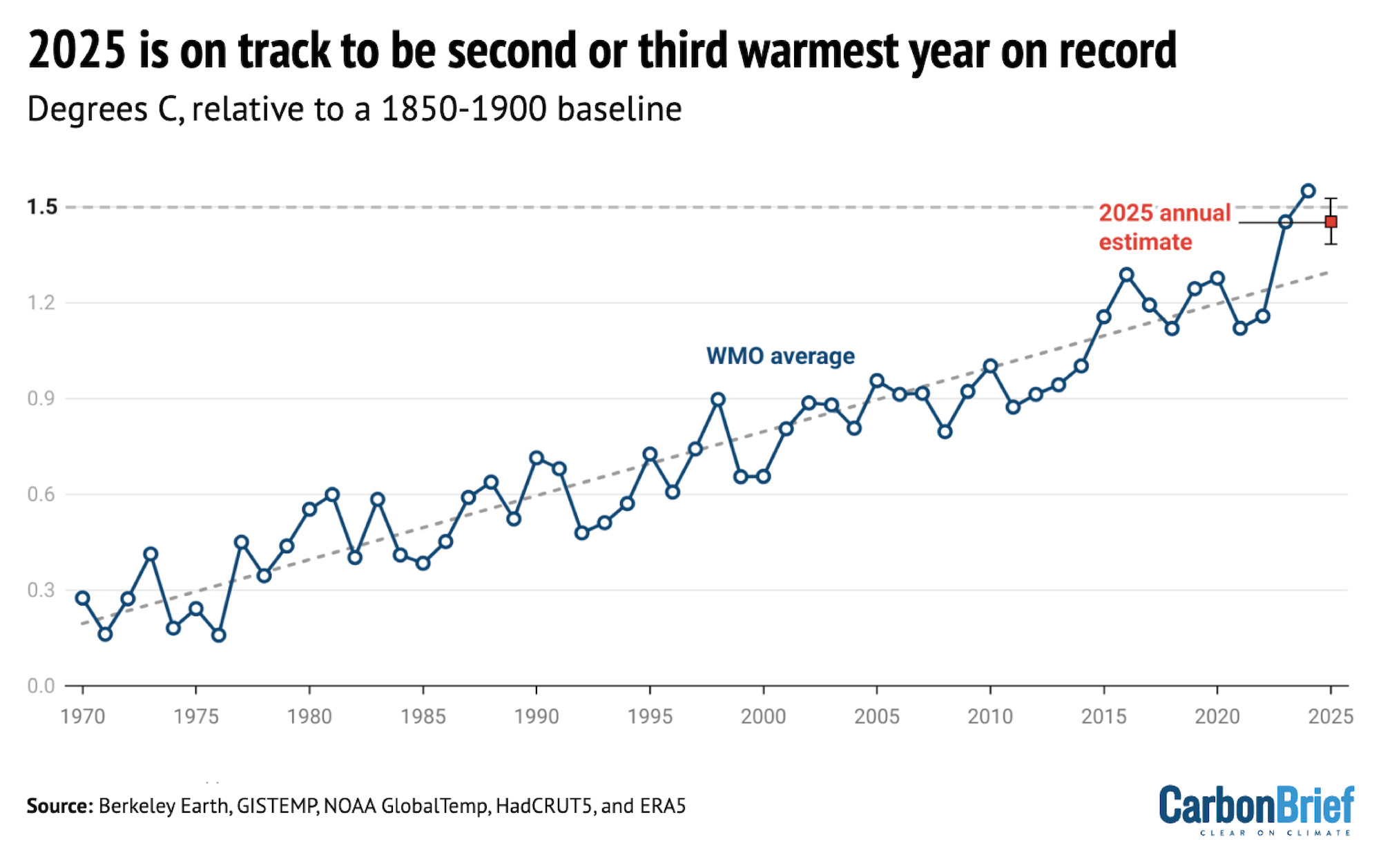
New analysis by Carbon Brief this week revealed that 2025 is on track to be the second or third hottest year on record. The chart above draws on data from five different research groups that report global surface temperature records to illustrate how 2025 saw the second-hottest first half of the year on record.
Spotlight
‘Thirst’ exhibition maps the water crisis
This week, Carbon Brief visits a London exhibition exploring the world’s worsening water crisis.
Intricate ink drawings on cotton paper explore interconnected issues in Nepal.
Global warming has melted glaciers in the region, causing flooding and infectious diseases, displacing human and non-human life.
Yet, through his drawings, Nepalese artist Karan Shrestha has created a mosaic of the Himalayan region that shows water as a signifier of extreme weather and a life-giving source to be shared.

His piece, “Water-giver, memory-keeper and the shifting forces”, is displayed at the Wellcome Collection for its “Thirst: In Search of Freshwater” exhibition.
Brought together by Wellcome curator and lecturer Janice Li, it features 125 objects that showcase the impact of climate change on water and its role in shaping health and ecosystems.
Li’s research into the etymology of “thirst” unravelled a global interpretation of water, reflecting the exhibition’s geographical breadth. She told Carbon Brief:
“Humans have faced really brutal and critical environmental crises and have, through a really deep innate knowledge of their own specific land, been able to devise monumental infrastructure to combat the crises they face.”
Just before Shrestha’s art in the exhibition are photographs taken by M’hammed Kilito.
In one picture, Kilito’s guide, Mustapha, looks into a dried-up well in a Moroccan oasis.
Climate change and human activities have resulted in the loss of two-thirds of oases in the country, according to information displayed at the exhibition.
Speaking about the photograph, Kilito told the Guardian that it looked like Mustapha was “praying for the return of something essential: water”.
Water adopts multiple faces in the exhibition: a vital yet scarce resource in certain pieces, a spiritual entity in others – and a destructive force.
Nothing makes the latter as clear as “Deluge” by photojournalist Gideon Mendel. Five screens display footage of the aftermath of severe floods around the world, captured by Mendel over 17 years.

Li told Carbon Brief:
“[Gideon] told me that, in the last two years, there’s always been a flood of that magnitude happening somewhere. He didn’t imagine that one day it would get to a point where he would have to choose which one to go to.”
Next to “Deluge” is a dome-like space where visitors can sit on bean bags and listen to glaciers melting in the Himalayas.
Though the exhibition confronts global water challenges, Li hopes it also reminds visitors of the resource’s beauty:
“Quite a few people told me they sit in the listening room for half an hour, really enjoying themselves and then guilt hits them because they’ve forgotten they’re listening to melting ice. But, this is the beauty of art, and a lot of beauty has come out of decay, destruction and deterioration because it also, sometimes, signals rebirth.”
Watch, read, listen
YAK HERDERS STRUGGLE: The Associated Press featured the stories of yak herders in India’s Himalayan mountains as climate change threatens their way of life.
PILOT ANXIETY: A Guardian documentary followed two airline pilots grappling with the climate impacts of their jobs.
‘IS DECARBONISATION DEAD?’: New York Times columnist Ezra Klein invited climate experts onto his podcast to discuss the future of renewable energy in the US.
Coming up
- 5-14 August: Second part of the fifth session of the Intergovernmental Negotiating Committee to Develop an International Legally Binding Instrument on Plastic Pollution, Geneva, Switzerland
- 9 August: UN international day of the world’s Indigenous peoples
- 11-15 August:UN Environment Programme’s International Methane Earth Observatory at AmeriGeo Week 2015: Earth Observations for the Americas, Bogotá, Colombia
Pick of the jobs
- Climate Justice Standard Lab, research associate in forest carbon and climate justice | Salary: $25-35 an hour. Location: Remote
- The Church of England, net-zero carbon programme decarbonising churches lead | £59,248. Location: Remote
- UN Office for Project Services, country engagement specialist and regional coordinator for eastern europe, Santiago network | Salary: Unknown. Location: Geneva, Switzerland
DeBriefed is edited by Daisy Dunne. Please send any tips or feedback to debriefed@carbonbrief.org.
This is an online version of Carbon Brief’s weekly DeBriefed email newsletter. Subscribe for free here.
The post DeBriefed 1 August 2025: Trump targets ‘endangerment finding’; Floods and heatwaves; ‘Thirst’ exhibition appeared first on Carbon Brief.
-
Climate Change2 years ago
Spanish-language misinformation on renewable energy spreads online, report shows
-
Climate Change Videos2 years ago
The toxic gas flares fuelling Nigeria’s climate change – BBC News
-

 Greenhouse Gases1 year ago
Greenhouse Gases1 year ago嘉宾来稿:满足中国增长的用电需求 光伏加储能“比新建煤电更实惠”
-

 Climate Change1 year ago
Climate Change1 year ago嘉宾来稿:满足中国增长的用电需求 光伏加储能“比新建煤电更实惠”
-

 Carbon Footprint1 year ago
Carbon Footprint1 year agoUS SEC’s Climate Disclosure Rules Spur Renewed Interest in Carbon Credits
-
Climate Change2 years ago
Why airlines are perfect targets for anti-greenwashing legal action
-
Climate Change Videos2 years ago
The toxic gas flares fuelling Nigeria’s climate change – BBC News
-
Climate Change2 years ago
Some firms unaware of England’s new single-use plastic ban







